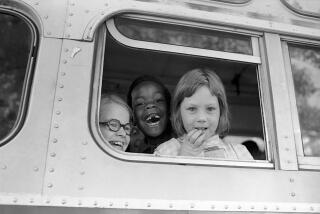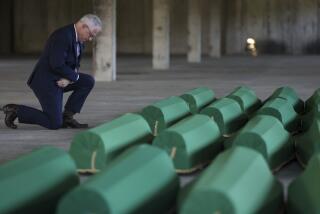Classrooms Point Up Bosnia’s Divisions
- Share via
NOVI SEHER, Bosnia-Herzegovina — It’s the second day of school, and classrooms are filling up with giggling Muslim children. But the building reserved for Croatian kids is eerily quiet, its classrooms empty.
Efforts to desegregate this primary school and others in ethnically divided Bosnia have so angered Croat parents that they are keeping their children home.
Like so many of Bosnia’s problems, the standoff at the Novi Seher school 50 miles northwest of Sarajevo is rooted in the 1992-95 war that pitted Muslims, Croats and Serbs against each other, killing 260,000 people and displacing more than half the population of 3.5 million.
Muslims sought an independent Bosnia, while the Serb and, later, Croat minorities wanted to be part of their ethnic kin next door. Bosnia ended up split into a Serbian sector and a Muslim-Croat one. And even though Croats and Muslims are now supposed to be sharing power as a federation, the divisions in the schools show how distant reconciliation remains.
Settling these feuds will be critical in determining how long Bosnia will remain under international administration, and how soon Bosnians can realize the one dream they all share: to become part of the prosperous, borderless European Union.
Serb-Muslim atrocities have captured the most headlines and tended to overshadow the Muslim-Croat divide, but remains so deep that their impact in schools reminds Robert Beecroft of Alabama and Mississippi before desegregation.
Beecroft is the American head of the Bosnian mission of the Organization for Security and Cooperation in Europe, a driving force in reforming Bosnia. He says that like U.S. segregation, the Bosnian version is “based on fear of the other, on a deep-seated conviction that others are inferior, and on a fear of assimilation.”
There’s nothing to tell Muslims, Serbs and Croats apart physically, and when they were all part of communist Yugoslavia, ethnicity was vigorously suppressed. But the war and its aftermath show how deeply it still runs. When Croat and Muslim families returned to their prewar homes, 51 of the schools in their half of the country were so thoroughly segregated, they were labeled “two schools under one roof.”
Officials recently introduced a national curriculum for core subjects that replaced the ethnic groups’ separate teaching plans. They also merged the leadership of divided schools and arranged for children to have their breaks at the same time.
But the classrooms themselves are allowed to remain segregated, and Beecroft says there’s no telling when that will change.
Overall, he believes that the reforms are taking hold “relatively well,” and that “everybody realizes that this is part of the ticket to Europe.”
But the changes strike Jelena Nuk, principal of the Croatian half of the school in the town of Vitez, as too much too soon. She says they are being foisted on Bosnia by international officials.
“Nobody is asking us anything. They are giving us orders,” she said.
Beecroft counters that the reforms are long overdue -- that “seven or eight years of students graduated under a broken system and got an inferior education.”
Mara Cajic, principal of the Croat part of the Novi Seher school, recalled how the first day of classes ended in a shouting match between parents and officials. Police arrived, but did not intervene. The children were sent home.
More than 100 of the school’s Croat children later enrolled in a Croat-run school a few miles away. It’s so crowded that students are taught in three shifts. The last ends at 7:30 p.m.
The reform seeks to head off anything that might give offense. New textbooks have been purged of inaccuracies and schools named after fighters who are heroes to one side or another have been ordered to find something more neutral.
Nationalist symbols such as the red-checkered Croat coat-of-arms have to be removed from school buildings, although it remains on the wall of Nuk’s office at the Vitez school. She says she’ll only remove it on orders from local officials -- not foreign ones.
Nadja Alihodza, Nuk’s counterpart in the Vitez school’s Muslim section, supports the reforms. Her building is smaller than the Croat one, and she hopes that change will mean more space and resources for her students, some of whom are jammed into tiny classrooms. This year, two rooms in the Croat building were opened to Muslim classes.
Segregated schooling made sense when Muslims first returned to Vitez, but no longer, Alihodza said. She hopes that all classrooms will one day be ethnically mixed.
“It’s better for the children,” she said.
In at least some towns in the Serb-run part of Bosnia, the picture seems more encouraging.
When Merima Jakupovic, 15, took the bus from her mainly Muslim town of Kozarac to nearby Prijedor to begin high school, she was nervous about the reaction from her new classmates -- all Serbs. Kozarac lies in a region where Serbs kept Muslims and some Croats in concentration camps during the war.
So far, things are going fine.
“I can’t be angry with them,” she said. “I’ll have to live with them. I help them; they help me. That’s how you must live.”
Previous rules said schools in the Serb half should use a Serb curriculum, but it was biased, said Osman Mujagic a Muslim teacher at Kozarac’s primary school. For instance, he said, it instructed teachers to take their students to the nearest monument honoring Serb war veterans.
“It happens to be Trnopolje, where I was held in a concentration camp,” he said.
Although it lies in Serb territory, the school eventually was allowed to use a Muslim teaching plan after protests by Mujagic and his colleagues.
Jakupovic, one of Mujagic’s former pupils, said her schooling in Kozarac was good, but not as good as in Germany, where she spent part of the war.
“The teachers explained more there,” she said. “Here, when I ask why the Serbs killed us, they only say, ‘It was war.’ When I ask why there was war, they say they don’t know.”
More to Read
Sign up for Essential California
The most important California stories and recommendations in your inbox every morning.
You may occasionally receive promotional content from the Los Angeles Times.










